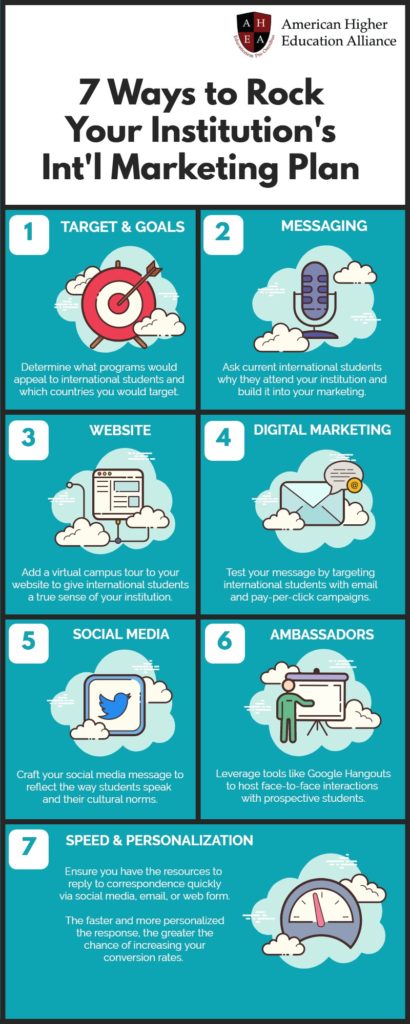
Seven Strategies to Enhance an International Marketing Plan

More and more U.S. colleges and universities are looking to international students as a way to bolster their enrollment numbers, create diversity on campus, and increase the institution's international reach and recognition.
Approximately one million international students studied abroad in the U.S. last year through academic programs and optional practical training (OPT). According to the Institute of International Education’s (IIE) Open Doors report, the overall number of international students studying in the U.S. increased by 1.5% last year. However, the number of new international students declined over the previous year by 6.6%.
Competition for these international students is not just limited to the U.S. but with universities abroad. For example, United Kingdom universities have reported a 30% increase in international student enrollment from China this year. To help your institution remain competitive, consider these seven strategies for creating a successful international recruitment plan.
1. Targets and Goals
First step in any plan is to determine your targets and goals. Are you looking to recruit for your undergraduate program? Your graduate program? OPT? English concentration? Or all of the above? Consider which are your strengths and which programs would appeal to international students, then define the enrollment goals for each one.
Which countries will you target? According to IIE, 51% of all international students in the U.S. come from China and India. By researching your current and past enrollment, you could uncover a hidden gem and find a concentration of students from a smaller country.
2. Messaging
It’s important to differentiate your institution and highlight how your institution stands out for the international market. According to the International Higher Education Report on Student Trends, there are two main reasons students want to study abroad: experience a new culture; and/or develop themselves personally. Does your marketing incorporate that message? What are your strengths with regard to international students?
One idea is to reach out to your current international students and alumni to find out why they came to your institution. What did they like? What would they change?
3. Website
Most international prospects will not be able to visit your campus to experience it first-hand. Your website will need to be the substitute.
First impressions are key and lasting. Your homepage must represent your institution and highlight international students and programs. Images tell a thousand words – even on the homepage. Students like to see students like themselves.
Access to your international pages needs to be easy to find on the homepage. These international pages should be based on the countries you are targeting and focused on the programs you hope to fill. Ensure your translation is current and localized – how the student speaks. Ask a current student to review it to make sure you are on target.
Adding a virtual campus tour to your international page gives the students a true sense of your campus. An added bonus would be to have the tour conducted by your international students.
4. Digital Marketing
Digital marketing is the cost-effective way to reach your targeted international students. Along with your email campaigns, you should consider adding pay-per-click (PPC) advertising. Not only can PPC convert prospects, but it is also a wonderful way to test your messaging since you only pay when someone clicks. Google has some wonderful tools to help you develop your PPC strategy. However, depending on your target countries, Google may or may not be the top search engine. For example, China uses Baidu.
5. Social Media
Social media is another great source to advertise your programs and test your messaging. Just like PPC, it changes based on the country of interest. China uses WeChat and Weibo. Make sure you do the research to find the right social media platforms to meet your needs. You also need to understand how the students speak, their cultural norms, and their expectations. Ask your current international students to help out.
6. Admissions Professionals and Ambassadors
Sending your admissions professionals abroad might be too costly. Your international alumni are a great resource to hold personal meetings and answer questions one-on-one. Many alumni would be excited to assist.
Although your admissions team might be grounded, that does not mean they need to be less personal. With Google Hangouts, your admissions team can have face-to-face interaction with prospective students.
7. Speed and Personalization
Before venturing down any marketing path, make sure you have the resources to respond to any correspondence quickly and personally – whether it’s social media, email, questionnaire form from a landing page, so on. The faster you answer the students’ questions the more likely they will apply. The response should come from a person whom the students can continually correspond with about your institution. Whether it’s an admissions professional or an army of your international students and alumni, fast, personal, and accurate information is critical to your conversion rates and meeting your goals.
Adding international students to your institution is a great way to add diversity to your campus, broaden your global reputation, and increase enrollment. Recruiting international students is very similar to recruiting here in the U.S. with some slight nuances. We hope you find this blog informative, and that it plays an instrumental role in the success of your institution’s international program.
